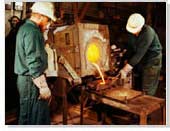
The wide range of casting alloys helps in selecting the most suitable and cost effective material that meets the requirements of a particular application. Each of these casting alloy has its own physical and mechanical properties. They also have their own casting characteristics, like:
- Weldability
- Machinability
- Corrosion resistance
- Heat treatment properties
|
Furthermore, the continuous research on alloying elements often results in the invention and development of more powerful and suitable casting alloys to meet the demands of industry applications. Selecting the proper casting method and the most suitable alloy are two major things that help in achieving optimum cost level for a specific.
There are two major categories for casting alloys:Ferrous Alloys Ferrous alloys are iron based alloys that has extensive use in wide range of industries because of its flexibility to meet strength, toughness, and impact of diverse industrial applications.
Steel- The properties of steels, determined by dispersion strengthening, depend on the amount, size, shape, and distribution of cementite (Fe3C).
- These factors are controlled by alloying and heat treatment.
- Surface Heat Treatment: The surface is quickly heated, quenched, and then tempered.
- Carburizing: Diffusion of carbon into the surface to increase the carbon at the surface.
- Nitriding: Similar to Carburizing but nitrogen (N) is substituted for carbon.
- Ferritic Stainless Steels (BCC): Up to 30% Cr and less then 0.12% C. Good corrosion resistance.
- Martensitic Stainless Steels: Cr < 17%. Heat treatable with the ability to form martensite among other phases.
- Austenitic Stainless Steels (FCC): Ni is an austenite stabilizing element.
- Grey Cast Iron: Interconnected graphite flakes in pearlite matrix. Good in vibration damping.
- White Cast Iron: Used for their high hardness and wear resistance. Martensite can be formed.
- Malleable Cast Iron: A heat treated unalloyed 3% carbon white iron.
- Nodular Cast Iron: The addition of magnesium (Mg) causes spheroidal graphite to grow.
Nonferrous Alloys Nonferrous alloys contain no iron at all and normally are costlier than ferrous alloy. The copper alloys are the largest product group among these alloys. Brasses and bronzes are the most popular copper alloys.
- Copper is alloyed with zinc to make brass. Most kinds of brass are easily shaped and have a pleasing appearance.
- Copper is alloyed mostly with tin to make bronze.
